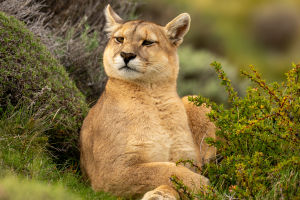
Let's clear this up first—mountain lions (also called cougars or pumas) are not lions. Even though their name has the word “lion” in it, they aren't closely related to the African or Asian lions we usually think of.
Mountain lions are actually part of the small cat family, while real lions belong to the big cat branch.
Some readers have asked, “If lions only live in Africa and Asia, what about mountain lions in America?” Good question! But mountain lions are a whole different species. So no, they're not the American version of lions.
How Lions and Mountain Lions Compare
They do have some things in common. For example, both lion and mountain lion cubs have faint spots when they're little, which fade as they grow up. But biologically, they're not close cousins.
Lions belong to the Panthera group (like tigers and leopards), while mountain lions belong to a separate group altogether.
A Quick Look at Real Lions
We're all familiar with the classic lion—big mane, strong roar, and a proud walk. Lions are the second-largest cats in the world (just after tigers), and they live mainly in Africa and a small part of India.
There are two main lion groups: African lions and Asian lions. In modern classification, there are eight lion subspecies, but some, like the Barbary and Cape lions, are already extinct.
Today, lions are only found in parts of Sub-Saharan Africa and a small forest in India (Gir Forest). Their habitats are shrinking and scattered, which is a big problem for their survival.
What Makes Lions Unique?
Lions are the only social big cats. They live in prides, usually led by females. Males develop large manes as they grow, which makes them easy to tell apart from lionesses.
Male lions weigh between 155–200 kg (340–440 lbs), while females range from 90–144 kg (200–315 lbs). Sadly, the global wild lion population is now between 23,000–39,000, and that number is still going down.
Their biggest threats? Habitat loss, hunting, poaching, and disease.
All About Mountain Lions
Mountain lions are the only members of their group (Puma) and are sometimes called “American golden cats.”
Traditionally, people recognized up to 32 subspecies based on where they live (like Florida panthers or California cougars). But modern science now groups them into 6 main subspecies, including the North American cougar and Chilean cougar.
What Do Mountain Lions Look Like?
Mountain lions are the fourth-largest cats in the world. They're slim, powerful, and built for agility.
Their heads are round, ears upright, and they've got large front paws with 5 retractable claws (the back paws only have 4). This setup helps them grab onto prey with serious force.
Coat colors range from light brown to gray, with white bellies. Males weigh between 53–100 kg (117–220 lbs), while females weigh 29–64 kg (64–141 lbs). Interestingly, cougars near the equator tend to be smaller than those closer to the poles.
Where Do Mountain Lions Live?
Mountain lions are only found in the Americas—from southern Canada through the U.S., and all the way down to the Andes Mountains in South America.
They're incredibly adaptable. Forests, deserts, cliffs, and even areas near farms can all be home. Back in the 1920s, they were so common in some regions that people bred strong dogs (like the Dogo Argentino) just to guard against them.
What Do Mountain Lions Eat?
They're skilled hunters and can climb, leap, and ambush like pros. Their diet is super flexible—anything from armadillos. But deer are their favorite.
In Yellowstone National Park, their main meal is elk, followed by mule deer. Even though they're not scavengers, studies in California show they won't say no to a deer carcass.
Are They Like Lions at All?
Not really. They're distant cousins, but they do share a few traits:
• Both have dark spots behind their ears
• Their fur colors are similarly plain
• Both have black-tipped tails, though it's more obvious in lions
Aside from that, mountain lions are loners, not pride animals like lions. And among wild cats, their closest relative is actually the cheetah, not the lion.
Are Mountain Lions in Danger?
Right now, mountain lions are listed as “Least Concern” globally—meaning they're doing okay, population-wise.
But their future isn't guaranteed. Urban growth, roads, and farms are chopping their habitats into isolated chunks. This leads to problems like inbreeding and food shortages.
How Many Are Left?
Worldwide, there are fewer than 50,000 mountain lions. In the U.S., they're actually increasing in some places:
• California: 4,000–6,000
• Oregon (as of 2017): around 6,400
• Florida: the only place where they're officially endangered
Human Conflicts and Sightings
People see mountain lions often, especially in the western U.S. In California between 2001–2004:
• 2001: 469 sightings, 15 lions killed
• 2002: 444 sightings, 14 lions killed
• 2003: 419 sightings, 3 lions killed
• 2004: 717 sightings, 13 lions killed
Although they're fierce hunters, mountain lions are shy and usually avoid humans. If you ever bump into one—make noise, spread your arms to look bigger, and chances are it'll run off.
What's Threatening Mountain Lions?
Here are the biggest dangers they face:
1. Habitat loss – Cities, roads, and farms break up their living spaces into isolated areas. That leads to inbreeding and fewer food options.
2. Conflict with people – When their food runs low, mountain lions may go after livestock—or even people. That usually leads to humans retaliating.
3. Hunting – It's legal to hunt them in some U.S. states. Texas, for example, has almost no rules: any licensed hunter can hunt one, anytime, no matter the age, or season.
4. Natural disasters – Fires and floods also harm their populations.
Why Should We Protect Them?
Mountain lions play a vital role in the ecosystem. They help keep deer and other herbivore numbers in check. Without them, things could spiral out of balance.
They're also valuable to science and biodiversity. Here's what we can do:
• Protect natural habitats – This is the most important step. If their land is safe, they'll survive.
• Set up protected zones – Many areas now have designated mountain lion sanctuaries.
• Educate people – Helping folks understand how to live safely around mountain lions can reduce conflict.
If you were surprised to learn that mountain lions aren't lions at all, you're not alone! Let me know, Lykkers—had you always thought they were true lions? Or did you already know the difference? 🐾


